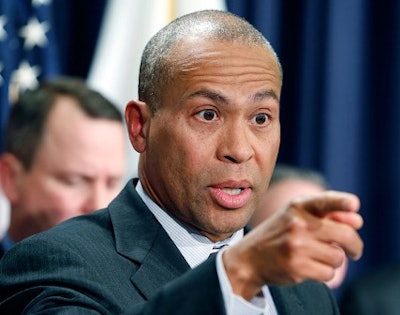 Massachusetts Governor Deval Patrick
Massachusetts Governor Deval PatrickMassachusetts has begun a community college funding effort that ties a significant share of a school’s budget to that institution’s progress in boosting graduation rates, ultimately helping meet state workforce needs.
With the state’s 15 colleges collectively receiving an additional $20 million this fiscal year over last year’s $208 million allocation, the shift to performance funding is expected to take a couple of years before it is fully implemented. The move, nonetheless, places Massachusetts in a cohort of fewer than a dozen states that, in recent years, have opted for performance funding to stimulate innovation and improve higher education outcomes.
“It’s part of a national story both because of the overall increased investment in public higher education that we are seeing this year in Massachusetts and because of the specific interest in the performance funding formula itself,” said Katy Abel, the Massachusetts Department of Higher Education associate commissioner for external affairs.
Public colleges in Massachusetts are getting an impressive 16-percent jump in state appropriations for the 2014 fiscal year over what they received in fiscal year 2013. Besides Massachusetts, several other states are seeing new public higher education investments this summer, which has been a reversal of declining state appropriations since the start of the 2008 recession.
“We are not unique in going to a performance funding model,” noted Abel, “But it is a major commitment that the state is making and you see that in the way the formula was structured.”
Abel explained that the formula calls for 50 percent of individual campus funding to be a “base appropriation,” accounting for student credit hours completed. The other 50 percent will be performance-based and will utilize a weighted formula that rewards campuses for improving their graduation rates, with emphasis placed on graduation rates of Pell-eligible students.
The Massachusetts plan of 50 percent performance-based funding makes the state’s initiative one of the most ambitious in the U.S., according to news accounts. In other states, just 5 to 10 percent of respective higher education budgets are being tied to performance.
“Massachusetts can go from laggard to leader here,” Paul S. Grogan, president of the Boston Foundation told the Boston Globe. “I’m very impressed with the zeal that the college presidents are displaying to show what they can do.”
In 2011, the Boston Foundation recommended the state shift to performance funding in a report that predicted heavy economic costs if community colleges did not improve their outcomes. Roughly 38 percent of job openings in the state requiring more than a high school diploma and less than a bachelor’s degree have gone unfilled for lack of qualified applicants, the Boston Globe has reported.
“We’re very pleased by this move on the part of the legislature and the governor,” Elizabeth Pauley, the Education to Career program director at the Boston Foundation told Diverse. “We think that tying community college outcomes for students will create incentives for colleges to meet the needs of both their immediate students but also regional economic demands.”
She continued, “The report in 2011 really pointed out those weak points” in the community college system, which included system shortcomings in its “alignment with K-12, the alignment with employers [and] the alignment with four-year bachelor degree-granting institutions.”
Abel noted that the state community college presidents and other leaders found common ground after collaborating during the 2012-13 academic year to devise the model for performance-based funding. That collaboration contrasted sharply with the disapproval community college leaders expressed when Governor Deval Patrick and others initially proposed reforms in 2011.
“[The agreement] was hammered out over the course of the last academic year, and then the formula was put in place with the budget that was just approved shortly after July 1,” said Abel.















